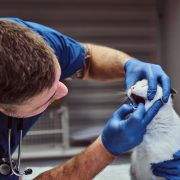Development of a checklist for the detection of degenerative joint disease-associated pain in cats
Development of a checklist for the detection of degenerative joint disease-associated pain in cats

Free access
In our edition of: Jun 2020
In our categories of: small animals
our summary:
Enomoto, M., Lascelles, B.D.X., and Gruen, M. E. (2020) Development of a checklist for the detection of degenerative joint disease-associated pain in cats. Journal of Feline Medicine and Surgery
The aim of this study was to develop a checklist that could be completed by owners and used to identify cats likely to have pain associated with degenerative joint diseases (DJD).
The study used data collected previously as part of the Translational Research in Pain Program at North Carolina State University; including data from studies on the prevalence of DJD, the development of outcome measures and studies that evaluated the efficacy of treatments for DJD. The studies included both owners of cats with DJD (DJD-informed group) and owners whose cat did not have DJD and who were considered to be unaware of DJD in cats (DJD non-informed group).
In all the previous studies, owners had been asked the same questions about their cats’ activity. For this study, the response scores for each cat and each question from these earlier studies were converted to binary impaired/unimpaired data and used to develop potential checklist questions which had yes/no answers.
The development of the checklist was a two-phase process. In phase one, the percentages of impaired scores for each question was evaluated, a calculation of sensitivity and specificity using data generated from DJD-informed owners was made, and a comparison carried out with data from DJD non-informed owners.
Phase two involved the selection of potential questions for the checklist. These questions were then combined, and their sensitivity and specificity as a combined set calculated. The number of questions was gradually reduced by eliminating those with the lowest sensitivity. Finally, the proposed checklist, which consisted of six questions, was applied to a recent clinical study to see whether it would be able to identify impaired (DJD) cats.
Based on the data in the recent study, it was found that the six questions would identify 99% of cats with clinically confirmed DJD and had a specificity of 100%. In the DJD non-informed group the sensitivity was 55% and the specificity 97%.
Limitations of the proposed checklist include: two of the six questions are about stairs which will not apply to all owners’ home setting; the low sensitivity with the DJD non-informed group and that the checklist was not evaluated in cats with other diseases. Therefore, positive responses to questions could potentially be generated for cats with, for example, neurological disease.
The proposed Feline Musculoskeletal Pain Screening Checklist offers an easy to use tool that may help veterinary surgeons screen cats for potential signs of DJD and engage owners in the monitoring of DJD associated pain behaviours in their cats. As a result, it may also help to raise awareness of this often underdiagnosed condition.
Further reading
For those interested in more detailed assessment and management of Degenerative Joint Disease, after the use of the screening tool, you may like to look at:
1. Monteiro, B.P. and Steagall, P.V. (2019) Chronic pain in cats: Recent advances in clinical assessment. Journal of Feline Medicine and Surgery, 21 (7), pp. 601-614 [summary available at: https://infocus.rcvsknowledge.org/chronic-pain-in-cats-recent-advances-in-clinical-assessment/]
Further information on the various metrology instruments currently available for assessing chronic pain in cats includes:
2. Comparative pain research – clinical metrology instruments [NC State College of Veterinary Medicine. Research Laboratories – Department of Clinical Sciences] [online] Available at: https://cvm.ncsu.edu/research/labs/clinical-sciences/comparative-pain-research/clinical-metrology-instruments/ [Accessed 22 June 2020]
3. Pain scales for use in cats with chronic pain [WSAVA] [online] Available at: https://wsava.org/wp-content/uploads/2020/01/Chronic-Pain_Cats.pdf [Accessed 22 June 2020]
4. Did you ever want to ask a cat how much pain they’re in? Use our FMPI [Feline Musculoskeletal Pain Index] [PAINFREECATS.org] [online] Available at: https://painfreecats.org/ [Accessed 22 June2020]
5. Client Specific Outcome Measures (CSOMf) – feline [NC State College of Veterinary Medicine. Research Laboratories – Department of Clinical Sciences] [online] Available at: https://cvm.ncsu.edu/wp-content/uploads/2019/11/CSOMf-form-2019A.pdf [Accessed 22 June 2020]
6. Klinck, M.P. et al. (2018) Development and preliminary validity and reliability of the Montreal Instrument for Cat Arthritis Testing, for Use by Caretaker/Owner, MI-CAT(C), via a randomised clinical trial. Applied Animal Behaviour Science, 200, pp. 96–105
7. Klinck, M.P. et al. (2018) Refinement of the Montreal Instrument for Cat Arthritis Testing, for Use by Veterinarians: detection of naturally occurring osteoarthritis in laboratory cats. Journal of Feline Medicine and Surgery, 20 (8), pp. 728–740
8. Klinck, M.P. et al. (2012) Owner-perceived signs and veterinary diagnosis in 50 cases of feline osteoarthritis. Canadian Veterinary Journal, 53 (11), pp. 1181-1186. Available online: https://www.ncbi.nlm.nih.gov/pmc/articles/PMC3474573/ [Accessed 22 June 2020]
Image copyright attribute: shopartgallerycom
Join the discussion
We encourage discussion on all material highlighted in each edition of inFOCUS. Use the button below to join the conversation on Twitter and include your comment in the feed for this issue.






Leave a Reply
Want to join the discussion?Feel free to contribute!